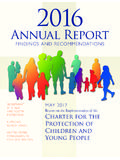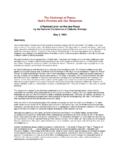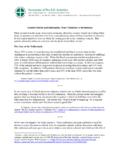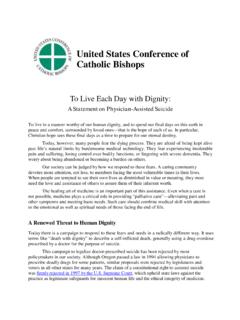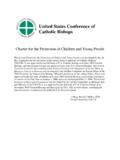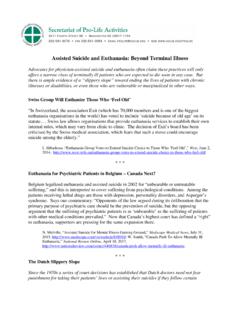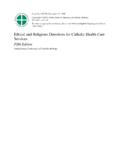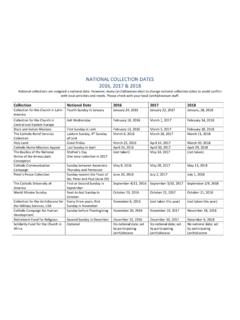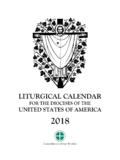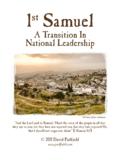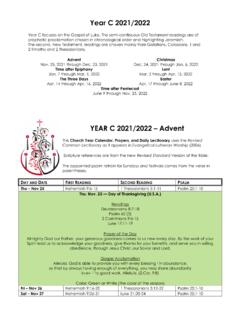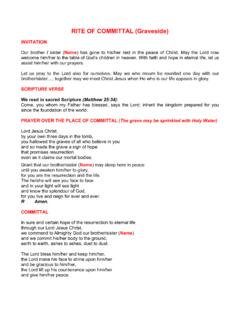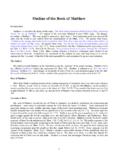Transcription of Co-Workers - USCCB
1 Co-Workers in the Vineyard of the LordA Resource for Guiding the Development of Lay Ecclesial MinistryUnited States Conference of Catholic BishopsThe document Co-Workers in the Vineyard of the Lord: A Resource for Guiding the Development of Lay Ecclesial Ministry was developed by the Committee on the Laity of the United States Confer-ence of Catholic Bishops ( USCCB ). It was approved by the full body of bishops at its November 2005 General Meeting and has been authorized for publication by the William P. Fay General Secretary, USCCBS cripture text on p. 7 is taken from the New American Bible, copyright 1991, 1986, and 1970 by the Confraternity of Christian Doctrine, Washington, DC 20017 and is used by permission of the copyright owner. All rights texts on pp. 19-20 are taken from the New Revised Standard Version Bible: Catholic Edition, copyright 1989, 1993, Division of Christian Education of the National Council of the Churches of christ in the United States of America.
2 Used by permission. All rights from the Catechism of the Catholic Church, second edition, copyright 2000, Li-breria Editrice Vaticana-United States Conference of Catholic Bishops, Inc., Washington, Used with permission. All rights from Vatican Council II: Constitutions, Decrees, Declarations, edited by Austin Flan-nery, OP, copyright 1996, Costello Publishing Company, Inc., Northport, are used with permission of the publisher, all rights reserved. No part of these excerpts may be repro-duced, stored in a retrieval system, or transmitted in any form or by any means electronic, mechanical, photocopying, recording, or otherwise without express written permission of Costello Publishing from the Code of Canon Law: Latin-English Edition, New English Translation. Transla-tion of Codex Iuris Canonici prepared under the auspices of the Canon Law Society of Amer-ica, Washington, Copyright 1998. Used with Printing, December 2005 ISBN 1-57455-724-6 Copyright 2005, United States Conference of Catholic Bishops, Washington, All rights reserved.
3 No part of this work may be reproduced or transmitted in any form or by any means, electronic or mechanical, including photocopying, recording, or by any information storage and retrieval system, without permission in writing from the copyright .. 5 Part One: Foundations .. 7A. Describing and Responding to New Realities .. 7 The Call to All Believers .. 7 The Call to the Lay Faithful .. 8 The Call to Lay Ecclesial Ministry .. 10 Reality of Lay Ecclesial Ministry .. 13B. Understanding the Realities in Light of Theology and Church Teaching .. 17 The Triune God: Source of the Church s Mission .. 17 Church: A Communion for Mission .. 19 Ministry: Serving the Church and Its Mission .. 20 The Bishop and Lay Ecclesial Ministers .. 21 The Priest and Lay Ecclesial Ministers .. 23 The Deacon and Lay Ecclesial Ministers .. 24 The Lay Faithful and Lay Ecclesial Ministers .. 25 Part Two: Pastoral Applications .. 27A. Pathways to Lay Ecclesial Ministry.
4 27 The Desire for Lay Ecclesial Ministry .. 27 Discernment of a Call to Lay Ecclesial Ministry .. 29 Determination of Suitability for Lay Ecclesial Ministry .. 31B. Formation for Lay Ecclesial Ministry .. 33 Introduction .. 33 Human Formation .. 36 Methods of Human Formation .. 37 Spiritual Formation .. 38 Elements of Spiritual Formation .. 39 Methods of Spiritual Formation .. 42 Intellectual Formation .. 42 Pastoral Formation .. 47 Integrating the Four Elements of Formation .. 50 Ongoing Formation .. 50 Agents of Formation .. 52C. Authorization for Lay Ecclesial Ministry .. 54 The Role of the Bishop in the Authorization of Lay Ecclesial Ministers .. 55 The Role of the Pastor in the Authorization Process .. 55 Specific Roles Covered by the Authorization Process .. 56 The Certification of Candidates for Lay Ecclesial Ministry Positions .. 56 The Appointment of Lay Ecclesial Ministers .. 57 Blessings and Rituals in the Authorization Process.
5 59 Additional Considerations .. 59D. The Ministerial Workplace .. 61 Context .. 61 Some Human Resource Areas in a Comprehensive Personnel System .. 62 Resources and Outcomes.. 64 Conclusion .. 66 IntroductionCo-Workers in the Vineyard of the Lord is a resource for diocesan bishops and for all others who are responsible for guiding the development of lay ecclesial ministry in the United States. For several decades and in growing numbers, lay men and women have been undertaking a wide variety of roles in Church ministries. Many of these roles presume a significant degree of preparation, formation, and profes-sional competence. They require authorization of the hierarchy in order for the person to serve publicly in the local church. They entrust to laity responsibilities for leadership in particular areas of ministry and thereby draw certain lay persons into a close mutual collaboration with the pastoral ministry of bishops, priests, and men and women of every race and culture who serve in parishes, schools, diocesan agencies, and Church institutions are identified by many differ-ent position titles.
6 In Co-Workers in the Vineyard of the Lord we identify them in a generic way as lay ecclesial ministers. We do so in order to reflect on what they have in common and to propose some understandings of lay ecclesial ministry situ-ated within our social and ecclesial environment and within the framework of the Church s belief, teaching, and pastoral offer this document as a pastoral and theological reflection on the reality of lay ecclesial ministry, as an affirmation of those who serve in this way, and as a synthesis of best thinking and practice. The following components provide the structure of the document: Theological foundations for lay ecclesial ministry Discernment and suitability for lay ecclesial ministry Formation of lay ecclesial ministers Authorization of lay ecclesial ministers Policies and practices in the ministerial workplace5We intend Co-Workers in the Vineyard of the Lord to be a common frame of reference for ensuring that the development of lay ecclesial ministry continues in ways that are faithful to the Church s theological and doctrinal tradition and that respond to contemporary pastoral needs and situations.
7 Unlike the USCCB documents Program of Priestly Formation and the National Directory for the Forma-tion, Ministry, and Life of Permanent Deacons, Co-Workers in the Vineyard of the Lord does not propose norms or establish particular law. It expresses at this point in history what we bishops have learned from the experience of lay ecclesial min-istry in the United States. It suggests concepts, goals, strategies, resources, and ideas to consider. It invites local adaptation, application, and implementation to achieve consistency where possible and to encourage diversity where appropriate. It calls Church leaders, ordained and lay, to become more intentional and effec-tive in ordering and integrating lay ecclesial ministers within the ministerial life and structures of our in the Vineyard of the Lord expresses our strong desire for the fruitful collaboration of ordained and lay ministers who, in distinct but com-plementary ways, continue in the Church the saving mission of christ for the world, his vineyard.
8 6 Part OneFoundationsA. Describing and Responding to New Realities You too go into my vineyard. (Mt 20:4)The Call to All BelieversGod calls. We respond. This fundamental, essential pattern in the life of ev-ery believer appears throughout salvation history. The Father calls a cho-sen people, patriarchs, and prophets. Jesus calls his apostles and disciples. The Risen Lord calls everyone to labor in his vineyard, that is, in a world that must be transformed in view of the final coming of the Reign of God; and the Holy Spirit empowers all with the various gifts and ministries for the building up of the Body of basic call is the same for all the followers of christ , namely that all Christians in whatever state or walk of life are called to the fullness of christian life and to the perfection of charity, and this holiness is conducive to a more human way of living even in society here on earth.
9 1 This foundational belief, announced with urgency by the Second Vatican Council, continues to be expressed not only through Church teaching but also, in diverse ways, through the lives of the 1 Second Vatican Council, Dogmatic Constitution on the Church (Lumen Gentium) (LG), no. 40, in Vatican Council II: Constitutions, Decrees, Declarations (rev. trans. in inclusive language), edited by Austin Flannery (Northport, NY: Costello Publishing, 1996). All subsequent Vatican II refer-ences come from the Flannery edition. 7 Christian faithful. For the call to holiness is an undeniable requirement arising from the very mystery of the Church. 2In this regard, the Council also taught that the forms and tasks of life are many but there is one holiness, which is cultivated by all who are led by God s Spirit.. All, however, according to their own gifts and duties must steadfastly advance along the way of a living faith, which arouses hope and works through love.
10 3 The Call to the Lay FaithfulLay men and women hear and answer the universal call to holiness primarily and uniquely in the secular realm. They are found in each and every one of the world s occupations and callings and in the ordinary circumstances of social and family life which, as it were, form the context of their existence. There they are called by God to contribute to the sanctification of the world from within, like leaven, in the spirit of the Gospel, by fulfilling their own particular duties. 4 For lay persons, this call, given in the Sacraments of Initiation, is rightly de-scribed as having a secular character that is properly theirs as laity. The secular nature of their calling refers to the fact that God has handed over the world to women and men, so that they may participate in the work of creation, free cre-ation from the influence of sin and sanctify themselves in marriage or the celibate life, in a family, in a profession and in the various activities of society.

